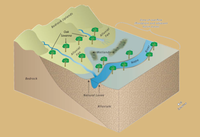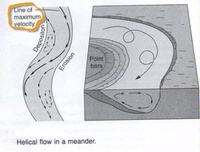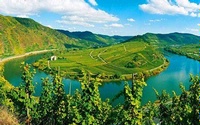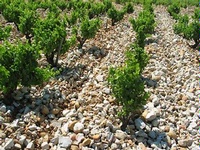|
|
 |

Wine folk are fond of making definitive pronouncements about specific soil types, as if the meaning of the term is self-evident. Thus, we hear about limestone, granite, Kimmeridgian, red slate, blue slate, schist, volcanic, and so on. One term that is casually broadcast in similar fashion is “alluvial,” in reference to soil. Let’s delve into the implications of this designation.
Alluvial soils are, by definition, those that are deposited by fluvial processes, i.e. flowing water. These diverse soils are created by rivers, creeks and streams in a variety of environments. As we consider the universe of alluvium, it’s clear that it encompasses a wide range of depositional circumstances, from a small mountain stream emptying onto a valley floor, to a massive river emptying into the ocean. We find alluvial impacts throughout the wine world.

Vineyards and Alluvial Soils along the Lot River in Cahors
Flowing water is a powerful medium for sediment transport. We observe the power of water in newscasts of flash floods and trapped autos and their occupants that make dramatic footage. Flooding, however, is a natural part of all fluvial processes. Large depositional changes do not happen very much during times of quiet flow. They do occur during flooding, when the increased volume of water has tremendous potential to re-sculpt the landscape. Although major floods are once or twice in a lifetime occurrence on a human timescale, they are frequent and regular events in geologic time that are expected and inevitable.
Let’s look at a fluvial system from top to bottom. Watercourses often have their headwaters in mountainous or upland areas with steep slopes and end in relatively flat plains as they wind their way to a larger river or ultimately to an ocean or sea. Where slopes are steep, the valleys tend to be straighter and have a V-shape. They often empty into a broad valley where their gradient becomes more gradual. At these points of inflection, the carrying capacity of the water drops significantly and it can no longer carry the sediment that it is transporting. We observe the result as an alluvial fan, where the sediments spread out in a fan shape across the valley. There are several notable alluvial fans in the Napa Valley as well as in other viticultural areas in the Golden State. The broad, fault-bounded valleys of California are similar to those of regions like Alsace and Burgundy in France in that the valleys have been filled with hundreds or even thousands of feet of alluvial sediments, washed into the lowlands as the bordering mountains rose.

Cross-section of the Napa Valley
When we consider major river systems, they are often flowing through rather flat lands and wind back and forth in arcuate forms called meanders. The question rises as to why the rivers do not naturally take a straight-line course rather than a curvaceous one. The answer is thought to lie in the internal flow of water in a river. Fluids flow in a corkscrew, or helical fashion. This natural rotation causes a stream to erode its banks on the outward edge of the rotation, causing a curve in the watercourse. As water flows through the curve, it flows faster and with more erosive power on the outward edge. The flow on the inner edge is slower, and we find that rivers deposit sediment on the inner part of the curve. Ultimately, the curves can erode themselves out of existence as they meet and form a cutoff, leaving the previous meander as an arcuate, oxbow lake. When we investigate the alluvial soils formed in this process, we will obviously find significant differences depending on the position of the former streambed.

Helical Flow in a Meander
If the land surface begins to rise, the meandering form can become entrenched. The river maintains its meandering pattern and, with enhanced energy from the uplift, cuts downward and forms a canyon. The Grand Canyon of Arizona is the most profound example of this process. In the wine world, the most noted example of entrenched meanders is the Mosel Valley of Germany, where the turn of the river changes the aspect of the slopes, giving some a sun-drenched, south facing and others a shaded, north-facing aspect -- topographic elements that define where grapes can ripen at this high latitude.

Mosel River Entrenched Meander
As we look at river systems and their natural processes, we know that the watercourses naturally move back and forth across their flood plains, depositing various lenses of sands, gravels, and clays as the go. A cross-section of an alluvial valley floor reveals an ever-changing sequence of various sediment sizes that can be very beneficial for grapevines, with the sands and gravels providing drainage and the clay lenses holding water that can be accessed by vine roots during periods of little or no rainfall.
Changes in sea levels as well as uplifts can offer alluvial soils in areas currently without much fluvial influence. The Russian River of northern California once flowed southward to San Pablo Bay. Tectonic forces caused uplift and changed the direction of the river to its current westward heading. The remnant sands and gravels of the previous course still provide well-drained vineyard sites. The southern Rhône River is noted as well for its ancient alluvial terraces, now high above the river, that imbue the vineyards of the Côtes-du-Rhône-Villages appellation with their gravelly, well-drained character.
The vineyards situated in the Médoc of Bordeaux have been profoundly influenced by fluvial and alluvial forces. The famous gravel mounds of Margaux, Pauillac and neighboring villages were transported there by the Dordogne and Garonne Rivers, swollen by outpourings of glacial meltwaters. The famous galets of Châteauneuf-du-Pape in the Rhône Valley were dropped there by similar glacial melting in the Alps. The vineyards of Cahors are set on sands and gravels deposited by the River Lot.

Châteauneuf-du-Pape Vineyard
The vineyard areas of Chile are named in accordance with the several rivers that transect the Valle Central, tumbling down from the Andes with great force during the high melt season. The deep soils that nourish vines in the Maipo, Rapel, and Curicó Valleys are alluvial in nature. So too, on the Argentine side of the Andes, run-off from melting snows has created the beneficial vineyard soils in Luján de Cuyo, the Valle de Uco and beyond.
Thus, when someone mentions that a particular wine is drawn from vineyards with alluvial soil, you will know that those soils can take many forms, depending on geologic history, slope, proximity to upland areas, rainfall patterns and more. While a specific vineyard site may have properties influenced by a particular stream in that spot, the fluvial influence takes so many forms that it is difficult to impose that set of characteristics on another alluvial area. It’s just another aspect of the great diversity and uniqueness of terroir.
|
 |
|